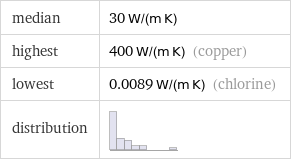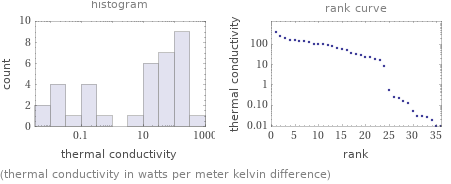Input interpretation

exploding massive star elements | thermal conductivity
Summary

median | 30 W/(m K) highest | 400 W/(m K) (copper) lowest | 0.0089 W/(m K) (chlorine) distribution |
Units

Distribution plots

(thermal conductivity in watts per meter kelvin difference)
Thermal conductivity rankings

1 | chlorine | 0.0089 W/(m K) 2 | krypton | 0.00943 W/(m K) 3 | argon | 0.01772 W/(m K) 4 | nitrogen | 0.02583 W/(m K) 5 | oxygen | 0.02658 W/(m K) 6 | fluorine | 0.0277 W/(m K) 7 | neon | 0.0491 W/(m K) 8 | bromine | 0.12 W/(m K) 9 | helium | 0.1513 W/(m K) 10 | sulfur | 0.205 W/(m K) ⋮ | | 27 | potassium | 100 W/(m K) 28 | cobalt | 100 W/(m K) 29 | zinc | 120 W/(m K) 30 | sodium | 140 W/(m K) 31 | carbon | 140 W/(m K) 32 | silicon | 150 W/(m K) 33 | magnesium | 160 W/(m K) 34 | calcium | 200 W/(m K) 35 | aluminum | 235 W/(m K) 36 | copper | 400 W/(m K)
Unit conversions for median thermal conductivity 30 W/(m K)

30 W/(m °C) (watts per meter degree Celsius difference)

0.3 W/(cm °C) (watts per centimeter degree Celsius difference)

0.3 W/(cm K) (watts per centimeter kelvin difference)

3×10^6 erg/(cm K s) (ergs per centimeter kelvin difference second)

1.4 BTU_IT in/(h in^2 °F) (IT British thermal unit inches per hour square inch degree Fahrenheit difference)

17 BTU_IT ft/(h ft^2 °F) (IT British thermal unit feet per hour square foot degree Fahrenheit difference)

0.072 cal_th cm/(s cm^2 °C) (thermochemical calorie centimeters per second square centimeter degree Celsius difference)
Comparisons for median thermal conductivity 30 W/(m K)

≈ ( 0.094 ≈ 1/11 ) × gold thermal conductivity ( ≈ 320 W/(m K) )

≈ ( 0.21 ≈ 1/5 ) × carbon thermal conductivity ( ≈ 140 W/(m K) )

≈ 0.37 × iron thermal conductivity ( ≈ 80 W/(m K) )